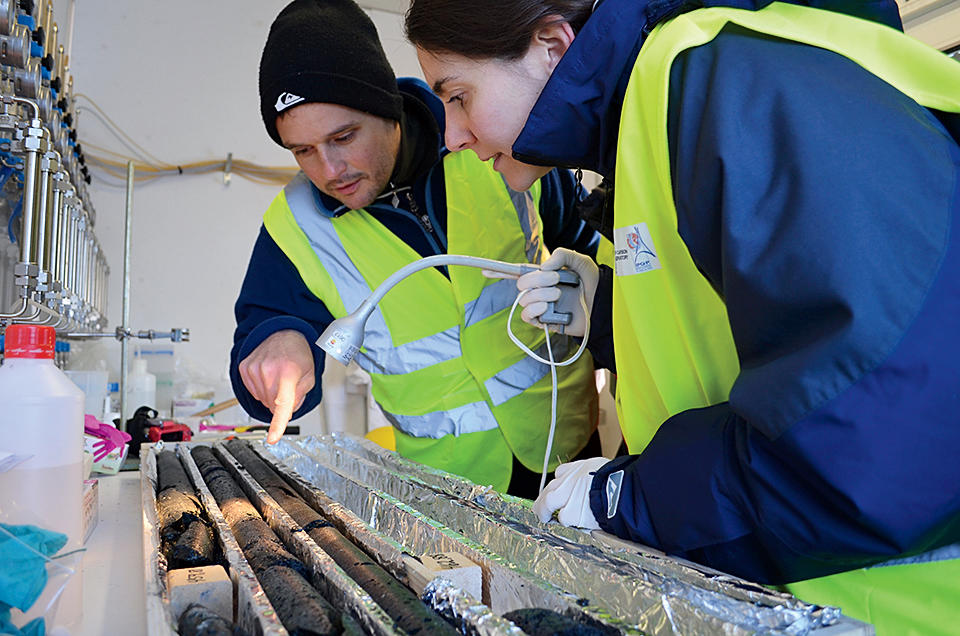Many scientists believe that in order to limit global warming, we must find a way to capture the carbon dioxide generated by power plants before it enters the atmosphere. To date, however, any attempts to store waste CO2 have met with limited success. Proposals that call for pumping it into abandoned wells or deep underground caverns, for example, have stalled, since no one is sure that the gas won’t eventually leak back into the air.
To address this concern, a team of scientists from Columbia’s Lamont-Doherty Earth Observatory and several other institutions have developed what they say is the safest, most reliable method for storing large quantities of CO2: turning it into stone. In a paper in the June 10 issue of Science, they describe how engineers at a major power plant in Iceland recently employed their technique to convert large quantities of CO2 into a mineral that resembles limestone. All that was required was mixing the CO2 with water and then injecting the fizzy solution deep underground, into holes bored in a common rock called basalt.
“When the CO2 solution came in contact with the rock, a chemical reaction took place that turned the carbon in the CO2 into a white, crumbly substance,” says Martin Stute, a Columbia hydrologist who is among the leaders of the research team. “It’s got a consistency like salt. And it’s chemically stable — the only way it would convert back into a gas is if you poured acid on it.”
Scientists have long known that CO2 will turn into a solid mineral called carbonate when it touches certain rocks that are rich in metals like iron, calcium, and magnesium. Evidence of this natural process can be seen in some parts of the world where freshwater springs containing trace amounts of CO2 flow over metal-rich rocks such as basalt or peridotite: the rocks, after years of chemically reacting with the CO2, will accumulate seashell-smooth, creamy-white carbonate crusts.
Until recently, however, geologists assumed that this process occurred too slowly to be of any use in sequestering waste CO2. They thought it would take hundreds or even thousands of years for a visible layer of carbonate to form. But Stute and his colleagues hypothesized that they could accelerate the process by mixing the CO2 with just the right amount of water and then exposing it to exceptionally metallic rock. The ideal rock to use, they decided, was basalt, which begins as magma deep within the earth’s mantle and is periodically pushed up to the surface by earthquakes or volcanic eruptions. Iceland, which rests almost entirely on volcanic rock, is 90 percent basalt.
In 2012, after fine-tuning their technique in a laboratory, the scientists joined forces with engineers at Iceland’s Hellisheiði geothermal power plant to begin pumping the facility’s CO2 emissions into the basalt beneath its property on the outskirts of Reykjavík. (Geothermal facilities, while relatively clean sources of electricity, do emit some carbon dioxide, because in the process of capturing steam from underground volcanic chambers, they also suck up CO2 and other gases.) The speed with which the chemical reaction occurred surprised everybody involved. “We’d originally anticipated that turning a sizeable amount of CO2 into carbonate might take ten or twelve years,” says Stute, who is a professor of earth and environmental sciences. “But we converted 250 tons in just two years.”
Based on this initial success, in 2014 the Hellisheiði facility started injecting CO2 at the rate of five thousand tons per year. The mineralization has since kept pace, prompting the plant’s operators to announce that they will soon double the injection rate.
While converting CO2 into stone appears to be a safe way of sequestering carbon emissions, it is not cheap. It currently costs the plant about thirty dollars to solidify a single ton of CO2, and fossil fuel–burning plants would likely face a much higher cost, since separating out the CO2 from their sooty exhaust is more difficult than drawing it out of the steam that propels the turbines at geothermal plants. Nevertheless, Stute and his colleagues say that if cap-and-trade agreements and other policies that aim to attach a cost to CO2 emissions become more common in the future, turning CO2 into stone could become financially attractive to increasing numbers of power plants.
“We believe that our approach could be used at any plant located near a large amount of basalt,” says Stute. “It opens up a world of possibilities for a CO2 sequestration strategy that until now wasn’t taken seriously.”




